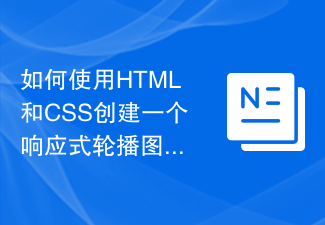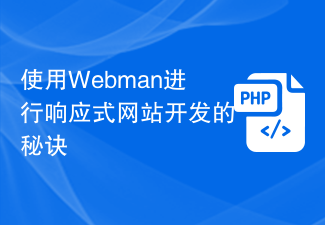
How to use Layui to implement responsive tab function
In front-end development, tabs are a common interaction method that can effectively organize page content. Improve user experience. When implementing the tab function, Layui is a very practical tool library. This article will introduce how to use Layui to implement responsive tab functions and provide specific code examples.
1. Introduction to Layui
Layui is a front-end UI framework developed by Xianxin (Xianxin is a famous domestic front-end developer). It is lightweight, easy to use, and efficient. Layui provides a wealth of components and interfaces to quickly build beautiful and feature-rich front-end pages.
2. The HTML structure of the tab
In Layui, the HTML structure of the tab follows certain specifications. The following is the standard structure of the tab:
<div class="layui-tab">
<ul class="layui-tab-title">
<li class="layui-this">选项卡1</li>
<li>选项卡2</li>
<li>选项卡3</li>
</ul>
<div class="layui-tab-content">
<div class="layui-tab-item layui-show">内容1</div>
<div class="layui-tab-item">内容2</div>
<div class="layui-tab-item">内容3</div>
</div>
</div>In the above code, .layui-tab is the container of the entire tab, which contains .layui-tab-title and .layui-tab-content are two parts. .layui-tab-title is the container of the tab title. Each tab title corresponds to a <li> element, where .layui-this means The currently selected tab. .layui-tab-content is a container for tab content. Each tab content corresponds to a <div> element, where <code>.layui-show means The currently displayed tab content.
3. Use Layui to achieve the tab effect
- <li>Introduce the Layui library
First, in the tag Introduce Layui’s CSS and JS files:
<link rel="stylesheet" href="https://cdn.staticfile.org/layui/2.5.6/css/layui.min.css"> <script src="https://cdn.staticfile.org/layui/2.5.6/layui.min.js"></script>
- <li>Initialization tab
After the page is loaded, call Layui’s elementmoduleinit()Method to initialize the tab:
layui.use('element', function(){
var element = layui.element;
// 初始化选项卡
element.init();
});- <li>Responsive layout
In order to achieve a responsive tab effect, you can use Layui's Responsive module. Wrap a <div> element outside the tab container and set <code>class="layui-tab layui-tab-card" to implement a card-style tab layout. Then, call the resize() method of the Responsive module to re-render the tab when the window size changes:
layui.use('element', function(){
var element = layui.element;
// 响应式选项卡布局
$(window).on('resize', function(){
element.tabResize();
});
});4. Complete sample code
The following is a complete sample code that shows how to use Layui to implement responsive tab functionality. Please introduce the CSS and JS files of the Layui library before use.
<!DOCTYPE html>
<html>
<head>
<meta charset="utf-8">
<title>利用Layui实现响应式的选项卡功能</title>
<link rel="stylesheet" href="https://cdn.staticfile.org/layui/2.5.6/css/layui.min.css">
<script src="https://cdn.staticfile.org/jquery/3.5.1/jquery.min.js"></script>
<script src="https://cdn.staticfile.org/layui/2.5.6/layui.min.js"></script>
</head>
<body>
<div class="layui-tab layui-tab-card">
<ul class="layui-tab-title">
<li class="layui-this">选项卡1</li>
<li>选项卡2</li>
<li>选项卡3</li>
</ul>
<div class="layui-tab-content">
<div class="layui-tab-item layui-show">内容1</div>
<div class="layui-tab-item">内容2</div>
<div class="layui-tab-item">内容3</div>
</div>
</div>
<script>
layui.use('element', function(){
var element = layui.element;
// 初始化选项卡
element.init();
// 响应式选项卡布局
$(window).on('resize', function(){
element.tabResize();
});
});
</script>
</body>
</html>Through the above code examples, we can easily use Layui to implement responsive tab functions. In actual development, you can modify the style and content of the tab according to your own needs, and add some other functions. Hope this article helps you!
The above is the detailed content of How to use Layui to implement responsive tab functionality. For more information, please follow other related articles on the PHP Chinese website!
 7款实用响应式Bootstrap电商源码模板(快来下载)Aug 31, 2021 pm 02:13 PM
7款实用响应式Bootstrap电商源码模板(快来下载)Aug 31, 2021 pm 02:13 PM好看又实用的Bootstrap电商源码模板可以提高建站效率,下面本文给大家分享7款实用响应式Bootstrap电商源码,均可免费下载,欢迎大家使用!更多电商源码模板,请关注php中文网电商源码栏目!
 如何使用HTML和CSS创建一个响应式轮播图布局Oct 20, 2023 pm 04:24 PM
如何使用HTML和CSS创建一个响应式轮播图布局Oct 20, 2023 pm 04:24 PM如何使用HTML和CSS创建一个响应式轮播图布局在现代的网页设计中,轮播图是一个常见的元素。它能够吸引用户的注意力,展示多个内容或图片,并且能够自动切换。在本文中,我们将介绍如何使用HTML和CSS创建一个响应式的轮播图布局。首先,我们需要创建一个基本的HTML结构,并添加所需的CSS样式。以下是一个简单的HTML结构:<!DOCTYPEhtml&g
 如何在Java 9中使用JavaFX来构建响应式UI界面Jul 30, 2023 pm 06:36 PM
如何在Java 9中使用JavaFX来构建响应式UI界面Jul 30, 2023 pm 06:36 PM如何在Java9中使用JavaFX来构建响应式UI界面引言:在计算机应用程序的开发过程中,用户界面(UI)是非常重要的一部分。一个好的UI能够提升用户体验,使应用程序更具吸引力。JavaFX是Java平台上的一个图形用户界面(GUI)框架,它提供了一套丰富的工具和API来快速构建富有交互性的UI界面。在Java9中,JavaFX已经成为了JavaSE的
 手把手带你了解VUE响应式原理Aug 26, 2022 pm 08:41 PM
手把手带你了解VUE响应式原理Aug 26, 2022 pm 08:41 PM本篇文章我们来了解 Vue2.X 响应式原理,然后我们来实现一个 vue 响应式原理(写的内容简单)实现步骤和注释写的很清晰,大家有兴趣可以耐心观看,希望对大家有所帮助!
 使用Webman进行响应式网站开发的秘诀Aug 14, 2023 pm 12:27 PM
使用Webman进行响应式网站开发的秘诀Aug 14, 2023 pm 12:27 PM使用Webman进行响应式网站开发的秘诀在当今数字化时代,人们越来越依赖于移动设备来访问互联网。为了提供更好的用户体验和适配不同尺寸的屏幕,响应式网站开发已经成为了一个重要的趋势。而Webman作为一个功能强大的框架,为我们提供了许多工具和技术来实现响应式网站的开发。在这篇文章中,我们将分享一些使用Webman进行响应式网站开发的秘诀,包括如何设置媒体查询、
 如何使用Vue和Element-UI实现移动端响应式设计Jul 21, 2023 am 10:49 AM
如何使用Vue和Element-UI实现移动端响应式设计Jul 21, 2023 am 10:49 AM如何使用Vue和Element-UI实现移动端响应式设计随着移动设备的普及,移动端响应式设计变得越来越重要。Vue和Element-UI是两个非常流行的前端开发工具,可以帮助我们快速实现移动端响应式设计。本文将带领大家学习如何使用Vue和Element-UI来开发移动端响应式设计,并提供代码示例。一、搭建项目环境在开始之前,我们需要先搭建一个使用Vue和El
 如何用Vue实现响应式UI设计?Jun 27, 2023 pm 02:35 PM
如何用Vue实现响应式UI设计?Jun 27, 2023 pm 02:35 PM随着当今Web前端开发技术的快速发展,许多前端框架也随之迅速崛起。而Vue.js作为其中的一员,因其轻量、易上手、灵活、高效、响应式等特点,越来越被广大前端开发者所青睐。在Vue的帮助下,我们可以很方便地实现响应式UI设计,提升用户交互体验,下面我们来详细介绍一下。一、什么是响应式UI设计?响应式UI设计是一种页面设计方法,其主要目的是根据不同设备的屏幕大小
 如何使用HTML和CSS创建一个响应式图片展示布局Oct 19, 2023 am 09:10 AM
如何使用HTML和CSS创建一个响应式图片展示布局Oct 19, 2023 am 09:10 AM如何使用HTML和CSS创建一个响应式图片展示布局在现代Web设计中,响应式布局已经成为一种标配,因为越来越多的人使用不同尺寸和分辨率的设备浏览网页。在本文中,我们将介绍如何使用HTML和CSS来创建一个响应式图片展示布局。首先,我们需要一个HTML文件来构建页面结构。在该文件中,我们使用HTML5的语义化标签来定义主要的布局结构。以下是一个简单的示例:&l


Hot AI Tools

Undresser.AI Undress
AI-powered app for creating realistic nude photos

AI Clothes Remover
Online AI tool for removing clothes from photos.

Undress AI Tool
Undress images for free

Clothoff.io
AI clothes remover

AI Hentai Generator
Generate AI Hentai for free.

Hot Article

Hot Tools

ZendStudio 13.5.1 Mac
Powerful PHP integrated development environment

EditPlus Chinese cracked version
Small size, syntax highlighting, does not support code prompt function

MantisBT
Mantis is an easy-to-deploy web-based defect tracking tool designed to aid in product defect tracking. It requires PHP, MySQL and a web server. Check out our demo and hosting services.

SublimeText3 Linux new version
SublimeText3 Linux latest version

mPDF
mPDF is a PHP library that can generate PDF files from UTF-8 encoded HTML. The original author, Ian Back, wrote mPDF to output PDF files "on the fly" from his website and handle different languages. It is slower than original scripts like HTML2FPDF and produces larger files when using Unicode fonts, but supports CSS styles etc. and has a lot of enhancements. Supports almost all languages, including RTL (Arabic and Hebrew) and CJK (Chinese, Japanese and Korean). Supports nested block-level elements (such as P, DIV),





